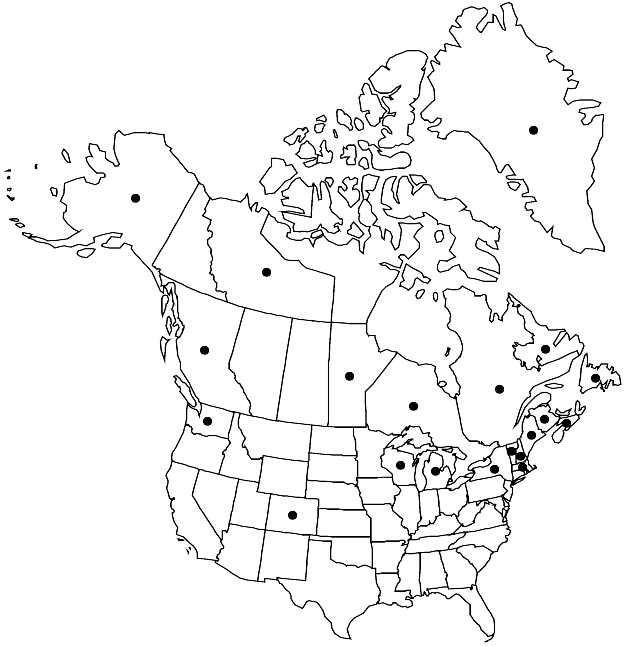Difference between revisions of "Pohlia bulbifera"
in C. F. Warnstorf et al., Krypt.-Fl. Brandenburg 1: 429. 1904.
FNA>Volume Importer |
FNA>Volume Importer |
||
| Line 26: | Line 26: | ||
|elevation=low to high elevations | |elevation=low to high elevations | ||
|distribution=Greenland;B.C.;Man.;N.B.;Nfld. and Labr.;N.W.T.;N.S.;Ont.;Que.;Alaska;Colo.;Maine;Mass.;Mich.;N.H.;N.Y.;Vt.;Wash.;Wis.;Eurasia. | |distribution=Greenland;B.C.;Man.;N.B.;Nfld. and Labr.;N.W.T.;N.S.;Ont.;Que.;Alaska;Colo.;Maine;Mass.;Mich.;N.H.;N.Y.;Vt.;Wash.;Wis.;Eurasia. | ||
| − | |discussion=<p>The gemmae of Pohlia bulbifera appear to be round to oblong because the four or five laminate leaf primordia are concave and form a dome over the gemma apex. The leaves are wide-spreading so the gemmae, although small, can be seen clustered in the distal leaf axils. This species sometimes occurs on peaty soils in bogs but also occurs on gravelly soils in disturbed places.</p> | + | |discussion=<p>The gemmae of <i>Pohlia bulbifera</i> appear to be round to oblong because the four or five laminate leaf primordia are concave and form a dome over the gemma apex. The leaves are wide-spreading so the gemmae, although small, can be seen clustered in the distal leaf axils. This species sometimes occurs on peaty soils in bogs but also occurs on gravelly soils in disturbed places.</p> |
|tables= | |tables= | ||
|references= | |references= | ||
| Line 50: | Line 50: | ||
|publication year=1904 | |publication year=1904 | ||
|special status= | |special status= | ||
| − | |source xml=https://jpend@bitbucket.org/aafc-mbb/fna-data-curation.git/src/ | + | |source xml=https://jpend@bitbucket.org/aafc-mbb/fna-data-curation.git/src/8f726806613d60c220dc4493de13607dd3150896/coarse_grained_fna_xml/V28/V28_329.xml |
|genus=Pohlia | |genus=Pohlia | ||
|species=Pohlia bulbifera | |species=Pohlia bulbifera | ||
Revision as of 17:04, 18 September 2019
Plants small to medium-sized, green, glossy. Stems 0.3–3 cm. Leaves ± erect, lanceolate, 0.9–1.4 mm; margins serrulate to serrate in distal 1/3; costa subpercurrent; distal medial laminal cells rhombic to rhomboidal, 65–95 µm, walls thin. Specialized asexual reproduction usually present when sterile; axillary gemmae 2–6, spheroid to obovate, shorter than leaves, yellow, orange, or green, leaf primordia restricted to apex and forming dome, laminate. Sexual condition dioicous; perigonial leaves ovate; perichaetial leaves scarcely differentiated, lanceolate. Seta orange-brown. Capsule inclined 95–180°, brown to stramineous, pyriform, neck 1/3 urn length; exothecial cells short-rectangular, walls sinuate; stomata superficial; annulus present; operculum convex-conic; exostome teeth yellow-brown, narrowly triangular-acute; endostome hyaline, basal membrane 1/2 exostome length, segments distinctly keeled, broadly perforate, cilia short to rudimentary. Spores 16–21 µm, finely roughened.
Phenology: Capsules mature summer (Jun–Aug).
Habitat: Acid, gravelly or sandy disturbed soil, path banks, stream banks, peaty soil
Elevation: low to high elevations
Distribution

Greenland, B.C., Man., N.B., Nfld. and Labr., N.W.T., N.S., Ont., Que., Alaska, Colo., Maine, Mass., Mich., N.H., N.Y., Vt., Wash., Wis., Eurasia.
Discussion
The gemmae of Pohlia bulbifera appear to be round to oblong because the four or five laminate leaf primordia are concave and form a dome over the gemma apex. The leaves are wide-spreading so the gemmae, although small, can be seen clustered in the distal leaf axils. This species sometimes occurs on peaty soils in bogs but also occurs on gravelly soils in disturbed places.
Selected References
None.